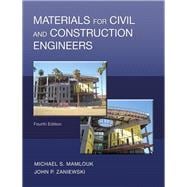Civil and Construction Engineering Materials: Properties, Uses, and Evaluations
Materials for Civil and Construction Engineers helps readers understand and select the materials involved in supporting the infrastructure needs of society--from buildings, to water and treatment distribution systems, to dams, highways, and airport pavements. By gaining a deep understanding of material behavior and the material selection process, readers can begin to understand how to create and maintain civil and construction engineering systems crucial to society.
The primary focus of the updates presented in this fourth edition was on the sustainability of materials used in civil and construction engineering. The information on sustainability was updated and expanded to include the most recent information. In addition, sections were added describing the sustainability considerations of each material. The problem set for each chapter was updated and increased to provide some fresh exercises. References were updated and increased in all chapters to provide students with additional reading on current issues related to different materials.










